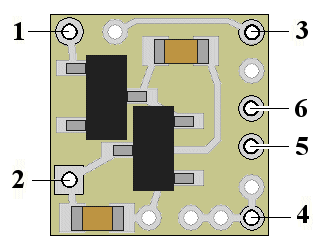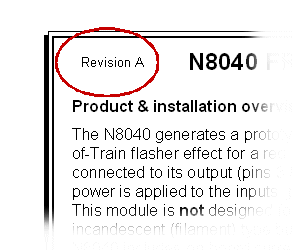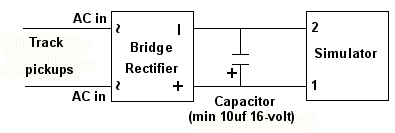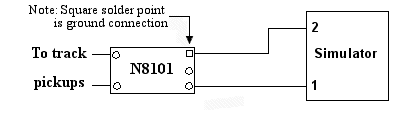Best viewed using:
Internet Explorer
or
Mozilla Firefox
Connecting the N8040 & N8040A FRED (EOT) Simulators
Installing the N8040 or the N8040A is very straightforward. Its tiny size and thin construction will allow it to be placed in many spaces too small for even the smallest Z-scale decoder. Because the module has circuitry on both sides, care must be taken to be sure that the components or wires soldered will not make contact with any metal object causing a short circuit.
Included with the module are two 6” lengths of #32 insulated wire. If necessary, these can be used for power input wires.

Figure 1
Powering options
Depending on available space, and type of rolling stock, our FRED Simulator can either be powered by a battery or by track pickups. If track power is to be used, we highly recommend also using our N8101 DC Power Source (1/2 the size of this simulator) for power conditioning. It will eliminate the problem of "unknown polarity" with DC (analog) operation, and "pseudo-AC or pulse noise" issues with DCC operation. Click here for more information on the N8101. Solder point #1 (see Fig 1 above) is the +DC power input connection, and solder point #2 is the -DC (ground) power input connection.
Revision A vs. original version note for N8040 or N8040A Simulators:
The latest version of these Simulators is Revision A. To determine which version you have, look in the upper left-hand corner of the instruction sheet that accompanies your Simulator module. It should look like figure 2 below if it is a Revision A. Otherwise, it will be the original version and this area will be blank.

Figure 2
There is one operational difference between these two versions.
With the original (non-rev. A) version ,when power is applied to either the N8040 or N8040A, the output connections for LED hookup (solder points 3 & 4) are by default, turned off. To turn on the FRED function, requires connecting solder point #5 (either momentarily or permanently) to -DC (ground). This version incorporated a special "latching" feature to turn on and off the FRED function and LED output. With power applied to the module, each time solder point #5 is grounded the FRED function alternately starts or stops. If #5 is connected to a push-button switch or a reed (magnetically activated) switch, the FRED can easily be turned off. Solder point #6 (next to point 5) is configured as a -DC (ground) for easy circuit connection.
With the newer Revision A version, this feature has been removed. Now, whenever power is applied to the Simulator, the FRED function is active. We found that the earlier "feature" caused some confusion by giving some users problems when running on battery power. The latching feature did turn off the LED output reducing the majority of power drain, but the tiny "trickle" required by the Simulator's microcontroller was still a gradual drain over time. This would eventually drain battery power.
Battery powering (N8040A)
Any alkaline, lithium or rechargeable battery can be used for power, providing the voltage output is no less than 5, or no more than 18 volts DC. The module's on-board voltage regulator and on-board resistor will maintain constant brightness for the FRED's LED over that voltage range.
While the N8040A only draws 3ma (with LED attached), it is recommended that for maximum battery life, the battery should be disconnected from the FRED circuit during periods of non-operation or storage. While current drain of the FRED module without the LED running is minimal, it is still a constant drain. The tiny batteries that would be used in the smaller (N and Z) scales have relatively low AH (Amp-hour) ratings. Even a tiny "trickle" will deplete them in a few days. An easy disconnect method would be to incorporate one of our N3200 Ultra-miniature Switches in the circuit, by connecting it in between the battery + and the FRED Simulator + (solder point 1). This switch is tiny enough that it can be easily concealed under most rolling stock, yet can be quickly "clicked" on or off.
Track powering
All of our Simulators require a clean DC voltage of known polarity for their power source, and the N8040 FRED Simulator is no exception. What does make a difference is the application for which the FRED is intended. In most cases our other Simulators provide functions that are either locomotive based or are for stationary applications. The FRED on the other hand, is for neither, it hangs out on the last car of a moving train.
Track power is typically provided in one of two forms. DC voltage (analog), or DCC.
Analog track power has been around for more than 75 years. Simply put, a DC voltage is applied to the two tracks with one being +DC and the other, -DC. Increase the voltage and the electric motor in the locomotive spins faster making the train go faster. If the train is required to reverse, track polarity is reversed so the loco's motor turns in reverse. Also, what defines "forward and reverse" is dependent on which way the loco is facing when it's put on the track. Bottom line here is that track polarity is not fixed. Our Simulator needs fixed polarity.
DCC track power is such that to devices requiring plain DC voltage, it looks like AC power. That is because voltage levels on each track go both + and – continuously. The DCC decoders in locomotives “descramble” the track signals and provide correct polarity so their motors can function normally. It is this process that will allow multiple locomotives to go in different directions on the same section of track, at the same time. A feature not available with analog track power. Once again, our Simulator needs fixed polarity and it needs to look like DC voltage.
Due to our Simulator's very small size, there is insufficient space to include additional circuitry and components necessary for proper power conditioning when direct track pickup is to be used. There are two solutions to this problem and both are inexpensive:
Discrete components
The Simulator can be powered from the track with the addition of two readily available components: a bridge rectifier (our N301S or N302S will work just fine). If DCC operation is used, the addition of a filter capacitor (10μf or larger and minimum 16-volt) will be required. Figure 3 below is schematic diagram of the connections required.
Figure 3
This is the least expensive solution, but is has a couple of minor drawbacks. First, the bridge rectifier (and capacitor, if needed) are not mounted on a circuit board so direct solder connection is required and you will need to ensure the pins on the rectifier and leads on the capacitor (depending on the type of capacitor) are organized so that they won't short out against anything. Second, depending on the physical size of the bridge selected (and capacitor, if needed) and the scale you're modeling, hiding these additional components so they're not noticeable can be a bit of a challenge (especially if your FRED is on a flatcar).
N8101 DC Power Source
A more elegant, but very slightly more costly ($3.95) solution would be to use our N8101 DC Power Source. It has all of the components needed, includes a circuit board with solder points, is extremely tiny (1/2 the size of our Simulator), has the lowest possible voltage loss (important for analog operators). Click here for more information on the N8101. Figure 4 below is schematic diagram of the connections required.
Figure 4
Important note: A low-wattage iron with a pointed tip should be used for connection of wires. Too much heat or solder can easily damage the wires, or module(s) and void their warranty.
Also, all connecting wires should be pre-tinned before soldering them to the module(s). This will make connection quick and easy and ensure excessive heat is not applied to the solder points.
When connecting the LED to the Simulator, proper polarity must be observed. LEDs are “polarity sensitive” and will not function if connected backwards. The N8040 and N8040A are configured to connect to a 20 ma LED with a device voltage of 1.85-2.0 VDC. This covers all of Ngineering’s Micro and Nano red LEDs, as well as many of the red LEDs available.
Using wire appropriate for the size of the LED and its placement, connect the LED cathode (the – connection) to point #3 on the module and connect the LED anode (the +) to solder point #4.
As noted above, when power is applied to the N8040, the output connections for LED hookup (solder points 3 & 4) are by default, turned off. This is important with battery operation for power conservation, but with track power it's less of a concern. If you desire to have the FRED functional whenever track power is present, simply solder a jumper between solder points 5 and 6.
This completes connection of the N8040 and N8040A modules. It is recommended that a thorough re-inspection of all connections and module placement be performed prior to applying power. We hope you enjoy the added realism our module provides.
© 2008 Ngineering























